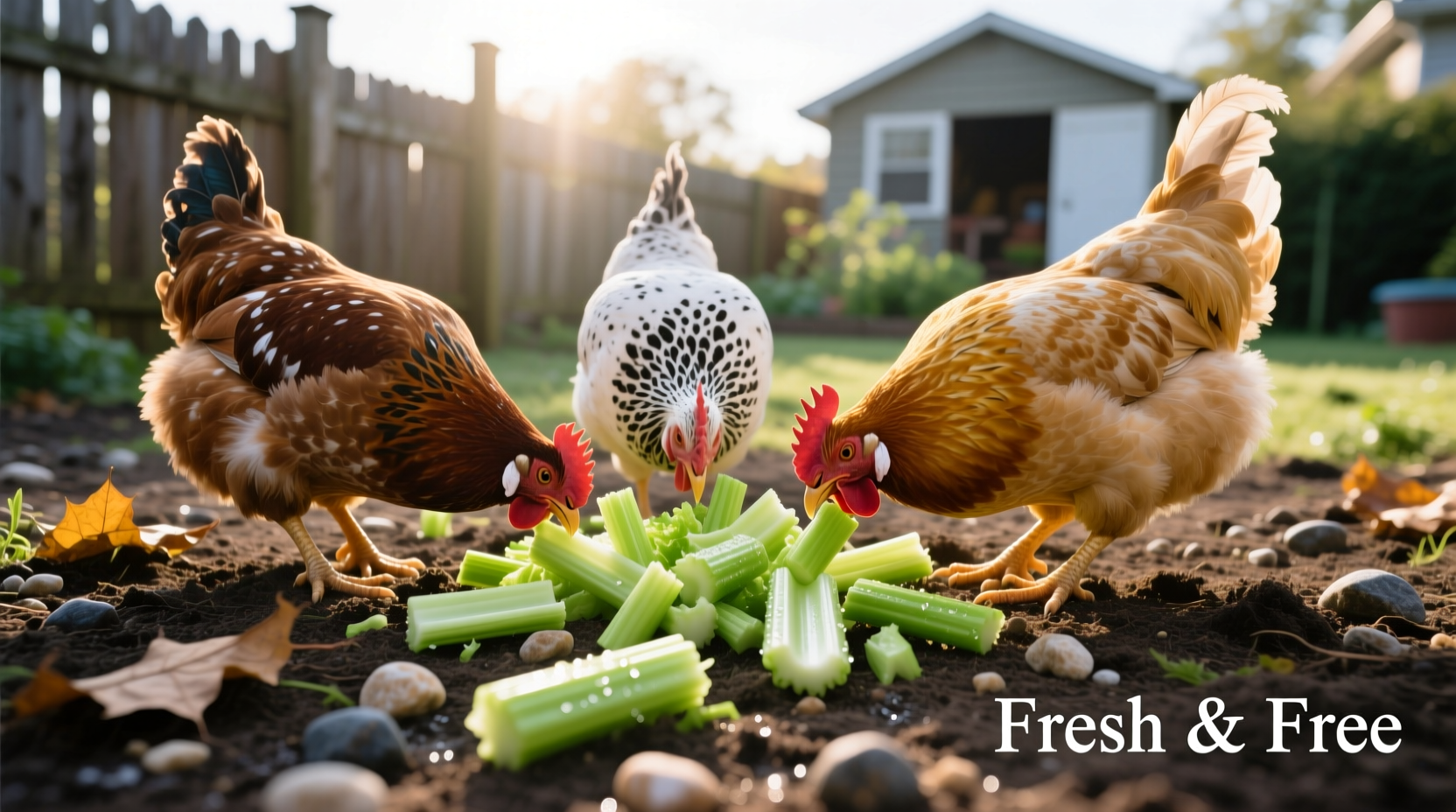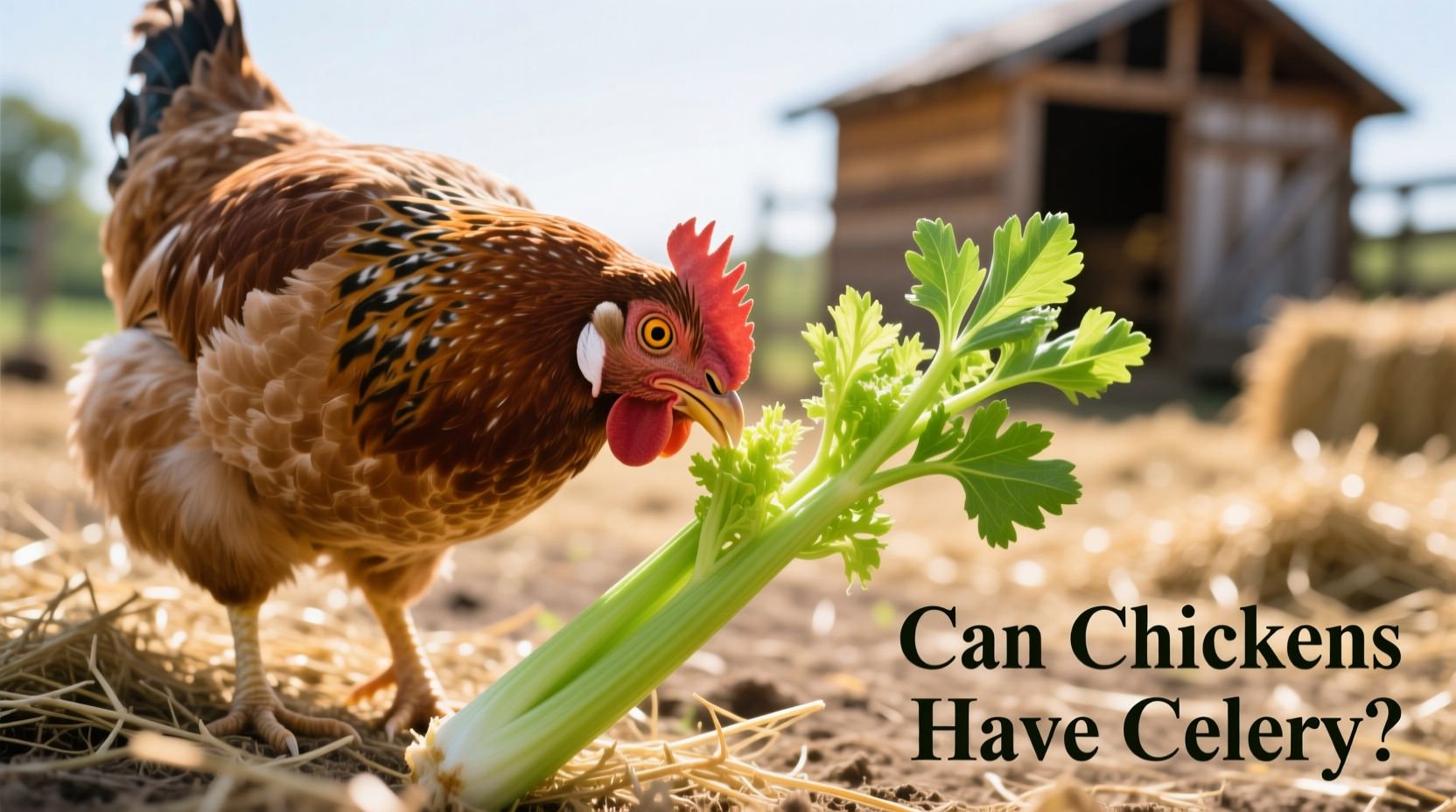YES, chickens can safely eat celery in moderation. This crunchy vegetable provides hydration and some nutrients, but should only make up 5-10% of their diet as it lacks complete nutrition for poultry. Learn exactly how to feed celery properly to keep your flock healthy.
As backyard chicken keeping grows in popularity, poultry owners increasingly ask about safe treat options. Celery often appears in kitchen scraps, making it a common candidate for chicken treats. Let's examine the facts so you can make informed decisions about your flock's nutrition.
Why Celery Works as a Chicken Treat
Celery offers several benefits when fed appropriately to chickens:
- High water content (95%) helps with hydration, especially during hot weather
- Provides vitamin K, potassium, and folate that support overall health
- Contains fiber that aids digestion in small amounts
- Offers mental stimulation as chickens peck and work to eat the fibrous stalks
| Nutrient | Amount in Celery (per 100g) | Benefit for Chickens |
|---|---|---|
| Water | 95g | Hydration support |
| Vitamin K | 29.6μg | Blood clotting and bone health |
| Potassium | 260mg | Electrolyte balance |
| Dietary Fiber | 1.6g | Digestive health in moderation |
How to Feed Celery to Chickens Safely
While celery is safe, proper preparation ensures your chickens get the most benefit without risk:
Cutting Technique Matters
Chickens can't chew like mammals, so they need food in manageable pieces. Always:
- Cut celery into ½-inch pieces to prevent choking
- Chop fibrous strings into smaller segments
- Remove tough ends that could cause crop impaction
Portion Control Guidelines
Treats should never exceed 10% of your chickens' total diet. For celery specifically:
- Laying hens: 1-2 small pieces per bird, 2-3 times weekly
- Chicks under 16 weeks: Avoid celery (their digestive systems are too delicate)
- Broilers: Limit to 1 small piece due to different nutritional needs

When Celery Might Cause Problems
While generally safe, celery presents risks in certain situations:
Context Boundaries: When to Avoid Celery
- Chicks under 4 months - Their digestive systems can't process fibrous foods
- Chickens with crop issues - The stringy fibers may worsen impaction
- During molting - Chickens need higher protein; celery offers minimal protein
- As sole treat option - Lacks complete nutrition when fed exclusively
According to the Penn State Extension Poultry Nutrition Guide, "Treats should complement, not replace, a complete layer feed. Vegetables like celery provide variety but cannot meet all nutritional requirements."
Celery Compared to Other Chicken Treats
Understanding where celery fits among common chicken treats helps you make balanced choices:
| Treat | Nutritional Value | Feeding Frequency | Special Considerations |
|---|---|---|---|
| Celery | Hydration, vitamin K | 2-3 times/week | Cut into small pieces |
| Leafy greens | High in vitamins A, C, K | Daily in small amounts | Avoid iceberg lettuce |
| Mealworms | High protein | 1-2 times/week | Excellent for molting birds |
| Fruits | Vitamins, natural sugars | 2-3 times/week | Remove pits/seeds |
Practical Feeding Recommendations
Implement these strategies for optimal results when feeding celery to your flock:
Best Preparation Methods
- Chop finely - Smaller pieces prevent selective eating (chickens often discard fibrous parts)
- Mix with other treats - Combine with leafy greens or mealworms for balanced nutrition
- Hang in the run - String celery pieces to encourage natural foraging behavior
Monitoring Your Flock's Response
After introducing celery, watch for these signs that indicate proper digestion:
- Normal droppings within 24 hours
- Continued egg production (for laying hens)
- No decreased appetite for regular feed
If you notice diarrhea, decreased activity, or reduced feed intake, discontinue celery immediately.
Complete Chicken Nutrition Perspective
Remember that celery should only supplement a complete diet. The USDA Agricultural Research Service emphasizes that "commercial layer feeds provide balanced nutrition meeting all requirements for egg production and health." Treats like celery enhance quality of life but cannot replace formulated feeds.
For optimal health, maintain this nutritional balance:
- 90-95% complete layer feed
- 5-10% healthy treats (including celery)
- Constant access to clean water
- Grit for proper digestion
Final Recommendations for Chicken Owners
Celery makes a safe, hydrating treat when fed properly to healthy adult chickens. Follow these guidelines for best results:
- Always chop celery into small, manageable pieces
- Limit to 2-3 times weekly as part of a varied treat rotation
- Never feed celery to chicks under 4 months
- Monitor your flock for any adverse reactions
- Remember that treats supplement but don't replace complete feeds
By following these evidence-based recommendations, you can safely incorporate celery into your chickens' diet while keeping them healthy and happy.











 浙公网安备
33010002000092号
浙公网安备
33010002000092号 浙B2-20120091-4
浙B2-20120091-4